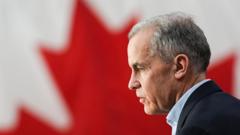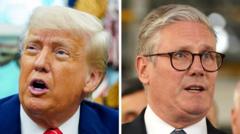In a stunning political turnaround, Mark Carney has been elected as Canada's Prime Minister, positioning himself as a formidable leader against U.S. trade threats. His planned strategy emphasizes diversifying trade relations and asserting Canadian independence as the nation braces for the impact of heightened tariffs and economic uncertainty.
Carney's Victory: A Shift in Canada's Trade War Strategy

Carney's Victory: A Shift in Canada's Trade War Strategy
Mark Carney's recent election as Prime Minister heralds a new direction for Canada amidst escalating trade tensions with the U.S. and ongoing economic challenges.
Mark Carney's recent election victory as Prime Minister marks a significant turning point in Canada's approach to navigating the ongoing trade war with the United States. On his final day of a challenging campaign in the vast nation, Carney's pivot from a central bank technocrat to a passionate public speaker was evident as he rallied support in Edmonton, Alberta. Dressed in a local hockey jersey, he declared, "President Trump has ruptured the global economy... America's leadership of the global economy is over."
Carney's election comes at a time when Canada faces heightened trade tensions with the U.S., compounded by Trump's imposition of tariffs citing national security concerns. His campaign presented him as the leader capable of confronting these threats, resonating particularly well in regions like Quebec, where concerns over American influence have spurred a return to support for the Liberal Party.
Throughout his campaign, Carney's strategy continually centered around the theme of Canadian sovereignty and a 'win-win' partnership with the U.S. Notably, he positioned Canada as a vital supplier of critical minerals, indicating a willingness to negotiate on equal footing with the U.S. He also hinted at strengthening trade relations with other key partners, showcasing his intent to diversify Canada's economic alliances.
Carney's message became particularly potent during the final rally along the US-Canada border, where he spoke from a symbolic location near the Ambassador Bridge—an essential conduit for trade. The groundswell from his supporters reflects a shift in the political landscape, where previously contrasting virtues of conservatism and liberalism converge against the backdrop of an external threat.
As Carney assumes office, he faces the pressing challenge of addressing economic fallout from existing tariffs while fostering a collaborative political environment within Canada. Despite falling short of a parliamentary majority, he aims for a "Team Canada" approach, welcoming discussions that could lead to significant trade adjustments with the U.S.
Carney's impending agenda includes preparations for the upcoming G7 summit in Alberta, where he intends to exert influence not just locally, but in global trade conversations, particularly amidst growing frustrations from traditional allies. With the potential expiration of reciprocal tariffs looming and pressures on the U.S. economy mounting, Carney's leadership will be closely watched as he navigates this intricate political and economic landscape.






















